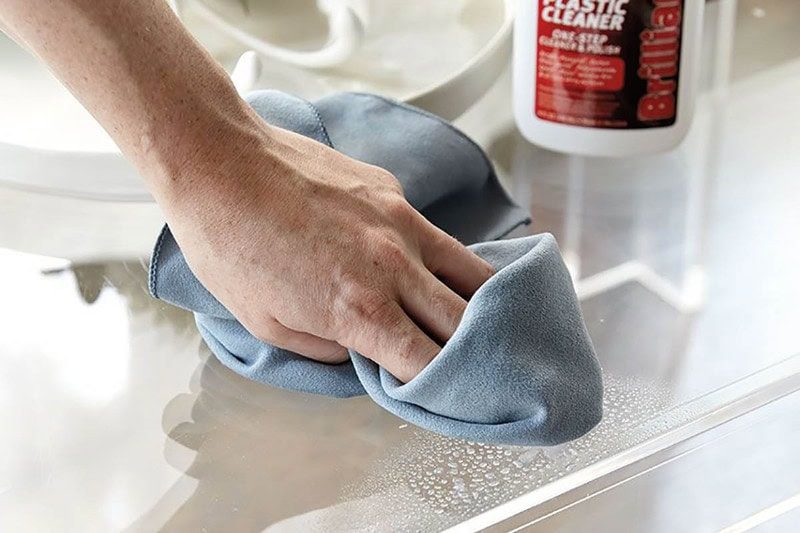Plexiglass, alternately branded as acrylic, has widespread applications due to many great virtues. Even the plastic material isn’t without its limitations regarding functionality and aesthetics. Plexiglas features a scratch-prone surface that is also susceptible to haze.
That’s why it requires special cleaning care, whether professional or at-home DIY measures. Maintaining the pristine condition is obligatory to preserve the functionality. This guide digs up the best practices of acrylic cleaning with gentle methods and suitable solutions.
Consequences of Improper Cleaning
Improper cleaning can introduce serious repercussions to plexiglass. The material is valued worldwide for clarity and versatility. Understanding the consequences can help customers realize and emphasize safe cleaning practices.
- Micro-Scratches: One of the most immediate and visible consequences is associated with dents. An acrylic plexiglass surface is softer than traditional glass. Therefore, abrasive cleaning tools or harsh methods can create micro-scratches.
- Compromised Visibility: Such tiny issues eventually accumulate to dull the material’s overall appearance. Scratch marks impair the transparency and reduce the metallurgic functionality for applications requiring clear visibility or light transmission.
- Clouding: It’s another issue that derives from improper cleaning solutions (too acidic formulas or ammonia based products). Their reaction with acrylic causes permanent discoloration or haze. Clouding also diminishes aesthetics and compromises architectural designs.
- Structural Damage: Improper cleaning for a long can weaken the structural integrity. Continuous exposure to abrasive tools, chemicals, and/or excessive pressure can degrade the surface. The clear plastic becomes brittle and prone to cracking.
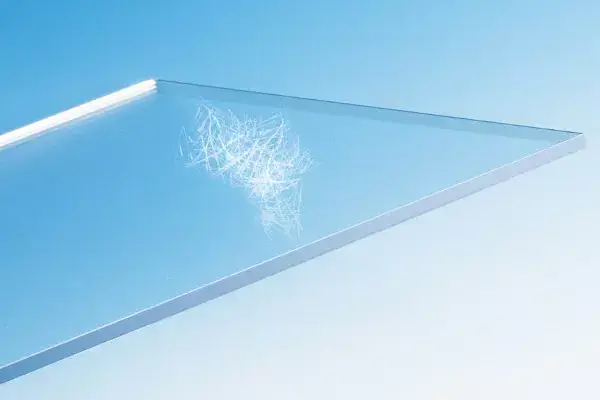
Understanding Plexiglass Properties
The plastic itself comes with brilliance, functionality, and longevity. Proper cleaning and maintenance allow plexiglass to hold its reliability and suitability across decorative and practical applications.
a. What Makes Plexiglass Scratch-Prone?
Acrylic glass or plexiglass with a scratch-prone surface has been one notable vulnerability. It comes from the inherent softness of Plexiglas compared to traditional glass, which has rigid silica structures, whereas plexiglass is a polymer.
That’s why it’s flexible and durable at the cost of surface hardness. Abrasive cleaning tools can easily leave a visible scratch on plexiglass.
Similarly, cleaning products containing harsh chemicals can degrade the surface through micro-abrasions. Those factors put the necessity of careful handling and appropriate materials at the forefront of maintaining the pristine condition.
b. Common Applications of Plexiglass
As mentioned, Plexiglas has many applications across industries due to its immense versatility. Some typical applications related to the cleaning process include –
- Windows: There are acrylic panels (windows) on aircraft, boats, and residential spaces. Lightweight acrylic provides durability and transparency.
- Displays: Retail displays, signage, and museum cases heavily rely on plexiglass. The material’s clarity and ability to showcase items are quite effective.
- Aquariums: Large aquariums and tanks utilize plexiglass. The plastics possess sufficient resistance to shattering along with excellent visibility.
- Protective Shields: Plexiglass has become indispensable for sneeze guards and face shields. It enables safety without obstructing the overall view.
Cleanliness seems critical across these settings. A scratched or clouded acrylic panel can obstruct views or disrupt light transmission, affecting its functionality.

Essential Tools and Materials for Cleaning Plexiglass
Appropriate tools and suitable materials are critical to maintaining plexiglass clarity and integrity. You must understand the right approach to keep the surfaces free from scratches, clouding, and/or dullness.
01. Recommended Cleaning Supplies
- Microfiber Cloths: Microfiber cloths are ideal for cleaning acrylic. It’s because the microfiber towel contains soft and non-abrasive fibres.
- The soft cloth can effectively trap dust and dirt, letting you avoid dust inhalation. Its lint-free nature also enables a glossy finish.
- Warm Water and Mild Soap: A simple solution of mild dish soap and water (warm) provides a gentle yet effective way to clean plexiglass.
- The non-corrosive soap makes it safe to remove dust and smudges. Special cleaners, exclusively for acrylic, are also excellent options.
- Distilled Water: Using distilled water is particularly beneficial for a streak-free clean. Standard tap water may contain minerals that leave spots or streaks.
- In contrast, distilled water ensures a flawless outcome without any contaminants in the solution.
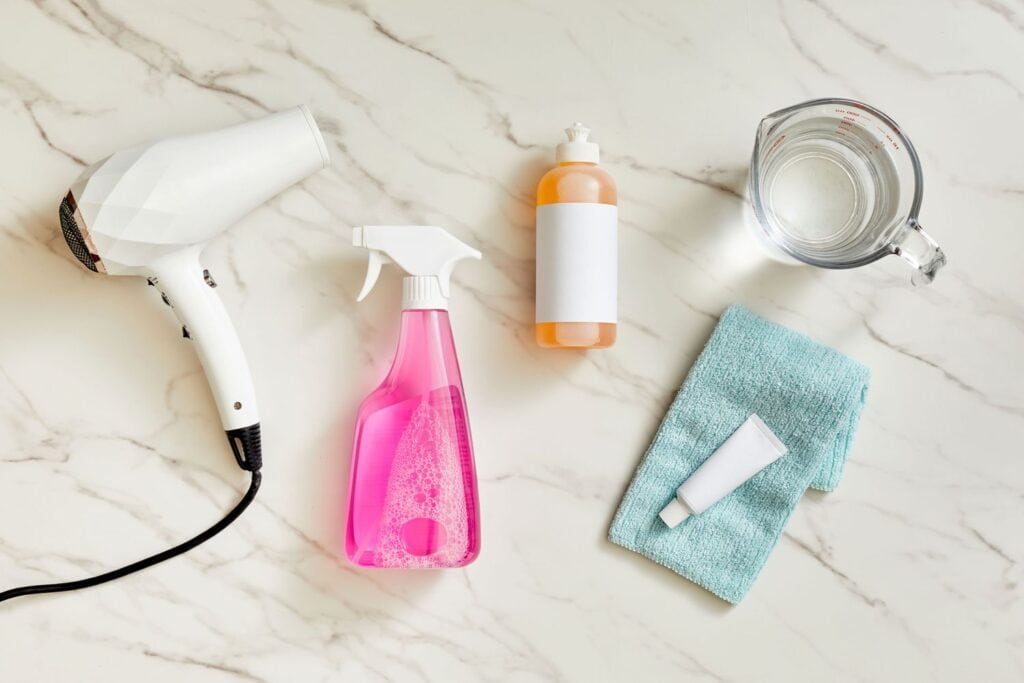
02. What are the Things to Avoid?
- Paper Towels: A paper towel has common uses in everyday cleaning. Surprisingly, a paper towel is harsh on acrylic plexiglass. The coarse texture of paper towels may cause fine scratch marks with dirt. Such damage can gradually diminish the material clarity.
- Harsh Chemicals: Products containing ammonia or isopropyl alcohol (often found in window cleaners) should be strictly avoided. Such chemicals can react with plexiglass materials. It leads to surface degradation, clouding, or hazing over time.
- Abrasive Cleaning Pads: Abrasive pads, scouring sponges, or steel wool are highly damaging to acrylic plexiglass. They can create deep scratches, ruining the overall appearance. Meanwhile, the pads may affect the material’s structural integrity.
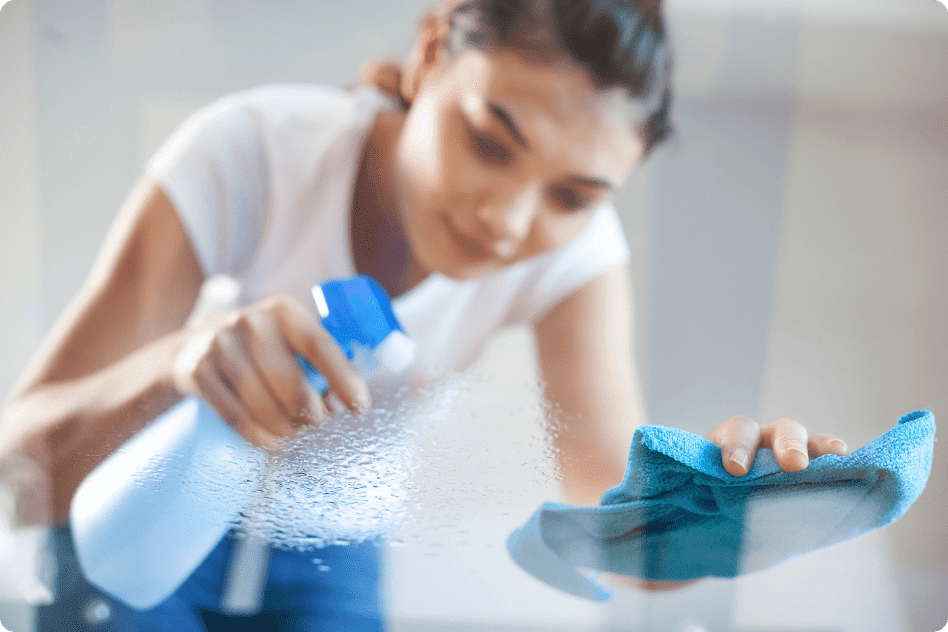
Step-by-Step Cleaning Process for Plexiglass
Retaining clarity and durability through cleaning requires a systematic approach. Explore all the individual steps involved in the standard acrylic maintenance process.
Step #01 – Pre-Cleaning Preparation
You must evaluate the plexiglass surface before everything else. It also marks the preparatory steps related to your probable actions and equipment.
- Assess the Surface: Closely check for loose dirt, dust, and/or debris. Remove such dust particles gently to avoid any mess-up during cleaning.
- Gather Tools: Get soft microfiber cloths, dish soap, distilled water, and specialized plastic cleaner. Keep the cleaning area free of abrasive materials.
Step #02 – Safe Cleaning Methods
- Rinse with Water (Warm): Start by gently rinsing the surfaces with water (warm). It helps dislodge loose particles that could scratch the plexiglass when wiped.
- Clean with Soap Solution: Prepare a mix of warm water and soap (mild). Soak a dry microfiber cloth in the solution and wring it to dampness. Gently wiping the plexiglass should do it.
- Use Circular Motions: Apply light pressure and move the clean microfiber cloth in a circular motion. The gently wipe minimizes streaks and reduces scratching risks.
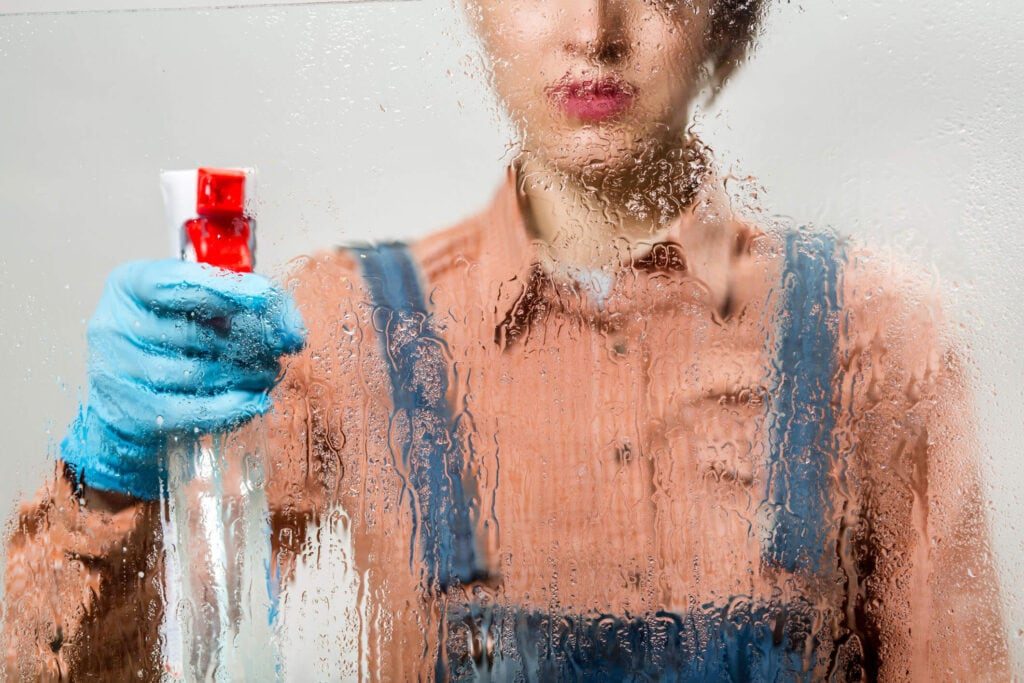
Step #03 – Drying Without Scratching
- Pat Dry: Employ a clean microfiber towel to pat the surface dry gently. Avoid rubbing too much, as even small particles can cause micro-scratches.
- Avoid Air Drying: Allowing the plexiglass air to dry under natural conditions can lead to water spots. It may diminish the aesthetic and functional qualities.
Step #04 – Dealing with Stubborn Stains
- Specialized Cleaners: Choose a plexiglass-specific cleaner to tackle harsh residues without harming the surface. Follow the manufacturer’s instructions for better results.
- Test in an Inconspicuous Area: Before applying the cleaner, test it on a small or hidden part of acrylics. It should demonstrate compatibility regarding unexpected damages.
Preventive Measures for Plexiglass Maintenance
Keeping up the longevity and clarity of acrylic glasses goes well beyond proper cleaning. You must proactively protect the plastic surface between cleanings and regular maintenance.
01. Protecting Plexiglass Between Cleanings
- Apply an Anti-Static Spray: Plexiglas naturally attracts dust and dirt due to its static-charged surface. Applying an anti-static spray through a spray bottle after cleaning often helps repel airborne particles, reducing the cleaning frequency.
- It also creates a protective layer to minimize dirt accumulation. Therefore, you can keep the surface clean and pristine for longer periods.
- Use Covers or Protective Films: Protective measures are essential, from frequent handling installations to harsh environmental exposure.
- Covers or removable protective films can shield the plexiglass from potential scratches, smudges, or ecological damage. It even adds a layer of security without compromising the transparency for simple or easy replacements.

02. Regular Maintenance Tips
- Schedule Routine Cleaning: Preventive care is all about consistency for the most part. Establish an appropriate cleaning schedule to prevent stubborn dirt or grime buildup.
- Such issues become more problematic and cannot be removed without potential risks. Regular upkeep for acrylic glasses ensures surface clarity and prevents dullness over time.
- Store Plexiglass Items Carefully: When not in use, plexiglass products should be stored to minimize the risk of accidental scratching (dents). Wrap the items in a lint-free and dry cloth.
- Then, place them in a dedicated storage area without abrasive or heavy objects. This exclusive precaution is important for smaller, portable plexiglass items (protective shields or panels).
Combine your protective strategies with consistent maintenance for all kinds of acrylic applications. It’ll let plexiglass remain visually appealing and structurally sound over extended periods.
Troubleshooting Common Issues with Plexiglass
You will likely encounter scratch marks or haze even with the most meticulous care. Fortunately, addressing such problems with the right techniques and preventive actions is possible.
A. How to Fix Minor Scratches?
- Plexiglass Polish or Scratch Repair Kits: Plexiglass polish or acrylic scratch repair kits are significantly effective in treating some minor dents. The kits are specifically designed to offer gentle wipe (buffing) for imperfections without harming the material.
- Apply a small amount of polish to a dry microfiber cloth. And rub it onto the scratched area in circular motions. Continue until the scratch fades to wipe (buff) the surface for a smooth matte finish.
- Sander Moving Techs for Deeper Scratches: Deeper scratches may require advanced repair methods like sanding. You should approach this method with great care to avoid causing further damage. Start with fine-git or coarse sandpaper (600 – 800 grit).
- Lightly sand the affected area in a single direction. Gradually move to finer sandpaper grits (1000 – 2000) for a smoother finish. Complete the process by applying a plexiglass polish to restore the clarity.

B. How to Avoid Hazy Appearance?
- Thorough Rinsing to Remove Cleaning Agents: A hazy appearance may arise when the cleaning agent isn’t thoroughly rinsed off the surfaces. Always employ and ensure a thorough rinsing with warm or distilled water.
- It applies to all kinds of cleaning solutions, such as mild soap or a special plexiglass cleaner. Such measures can help remove all residues to leave streaks or haze behind.
- Avoid Overuse of Products That Leave Residue: Some cleaning products, especially the ones not for plexiglass, can leave a surface-clouding residue. Always choose cleaners exclusively formulated for acrylic plexiglass or soapy water solutions.
- Also, avoid overapplying the cleaning products. Apply a small amount and wipe it away completely to maintain the plastic material clarity.
Addressing minor dents requires appropriate repair techniques. Preventing haziness requires careful rinsing and product selection. That way, plexiglass can hold its pristine look and functionality.

How to Clean Damaged Plexiglass: Addressing Heavily Damaged Sections
The plexiglass can sustain significant damage for various reasons. Cleaning such heavily damaged acrylic glass requires extra caution and attention.
a. Assessing the Extent of Damage
Likewise, you’ll have to evaluate the extent of the damage to proceed to action. Look for deep scratches, extensive clouding, or cracks that compromise structural integrity.
Determine whether the damage is localized or affects the entire surface. Heavily damaged plexiglass may require more than routine cleaning. Some areas may be beyond repair and need professional intervention or replacement.
b. Cleaning and Repairing Heavily Damaged Sections
For Deep Scratches: Begin with a gentle sanding process using a more coarse sandpaper or ultra-fine sandpaper (1000 – 2000 grit). Sand lightly in a single direction to smooth out the scratch marks.
Then, switch to circular motions for a uniform finish. Follow up with a plexiglass polish to restore the clarity. The process requires patience and care to avoid worsening the damage.
For Cloudy or Hazy Surfaces: Apply a specialized plastic cleaner or a water (warm) solution and mild soap. Gently wipe (buff) the surface with a soft microfiber cloth as standard procedure.
However, haze resulting from chemical damage or residue buildup can’t be removed through cleaning. You’ll need professional-grade restoration kits or services for those.
For Cracks or Structural Damage: Avoid aggressively applying massive pressure or cleaning for any cracks. Such acts may eventually cause further splitting.
Cracked plexiglass generally can’t be fully restored. However, small cracks may be stabilized with acrylic adhesives. For extensive cracks, replacement is most likely the best option.

c. When to Seek Professional Help?
Sometimes, the damage severely compromises the plexiglass product’s functionality and/or safety. It’s particularly true for large aquariums, windows, transportation, or protective shields.
You better consult professionals to assess whether it’s time for repair or replacement. Extensive scratching, hazing, or discoloration that can’t be rectified may also require restoration or replacement.
d. When to Replace the Plexiglass?
Replacement feels like an expensive option for many. However, it’s actually more cost-effective when –
- Damages span a significant portion of the surface.
- Cracks threaten the structural stability or integrity.
- Cleaning and repair efforts fail to restore the clarity.
Seek high-quality replacements and consider installing protective films to minimize potential damages.
Frequently Asked Questions (FAQs)
- Can scratches on plexiglass be removed entirely?
It’s possible to wipe out (buff or remove) minor scratches through plexiglass polish or repair kits. But deeper scratches may require sanding and polishing techniques. You may have to consider immediate and direct replacement as soon as possible for severe damages.
2. What is the best way to prevent water spots after cleaning acrylic?
Using distilled water for rinsing is the key to avoiding mineral deposits from running water. In addition, pat the surface dry with a microfiber cloth instead of letting it air dry for a streak-free finish.
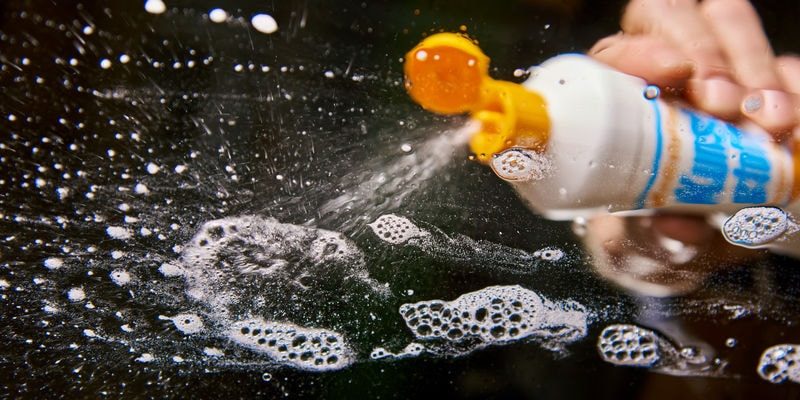
3. Why is plexiglass more prone to damage than glass during cleaning?
Plexiglass is softer than traditional glass due to its polymer composition. That’s why clear plastic is more susceptible to scratching, clouding, and reactions upon exposure to abrasive tools or harsh cleaners.
4. What’s the safest way to clean plexiglass with intricate designs or tight spaces?
Many decorative and furniture items have intricate shapes or tight corners. Choose a soft-bristled brush (non-abrasive) or cotton swabs dipped in soapy water. It enables precise cleaning without risking the surface for probable damage.
5. Can regular glass cleaners be used on plexiglass?
No, don’t even think of using regular cleaners. Common glass cleaners contain ammonia, alcohol, or other harsh chemicals to a great extent. Such compounds can easily damage plexiglass. Always go for cleaners designed for acrylic surfaces or soap solutions.

6. How often should plexiglass be cleaned to maintain its clarity?
Routine cleaning every 1 – 2 weeks is ideal for maintaining clarity and preventing buildup of dust or grime. However, the frequency may vary depending on environmental factors and the usage conditions.
7. Are protective films effective for long-term Plexiglass maintenance?
Protective films are highly effective in shielding plexiglass from scratch marks, smudges, and environmental exposure. They are particularly beneficial for outdoor installations (signs or displays) or frequently handled items (furniture).
8. What DIY techniques can be used to restore damaged plexiglass?
Many DIY enthusiasts choose their own methods of restoring damaged plexiglass. You can use ultra-fine sandpaper (starting from 600 grit and progressing to 2000 grit) for deep scratches. Applying mildly soapy water or specialized plexiglass cleaners works well for stubborn stains or light haze.
Conclusion
Cleaning is integral to modern maintenance, especially for crystal clear plastics acrylic plexiglass. Proper cleanup is obligatory to preserve the material’s highly-valued clarity and durability. Get the right tools (not the abrasive ones) to make the most of your cleaning. Otherwise, it’s more likely to cause a disaster through scratched haze, compromising the beauty and functionality.
Choose JUMEI ACRYLIC for the Best Quality Plexiglass
Are you looking for the best acrylic plexiglass supplier who can help you with the delivery and cleaning? Look no further than Jumei Acrylic Manufacturing to deliver your purchase solutions.
We own the best tools, methods, experiences, and innovation through industry-leading minds. Share your project details through Contact Us without hesitation and get professional consultation from the experts.

